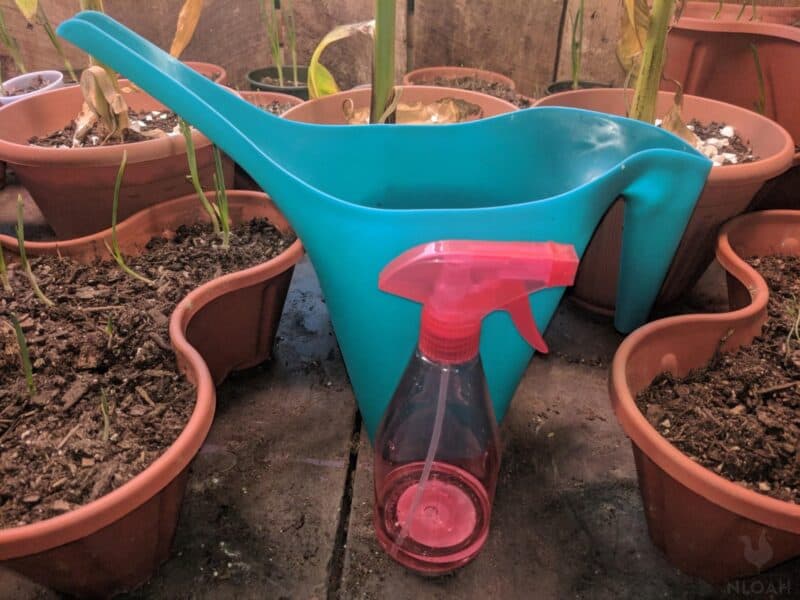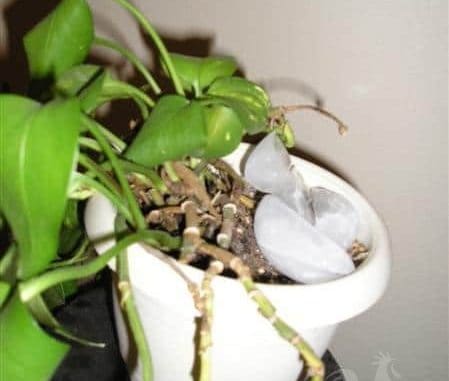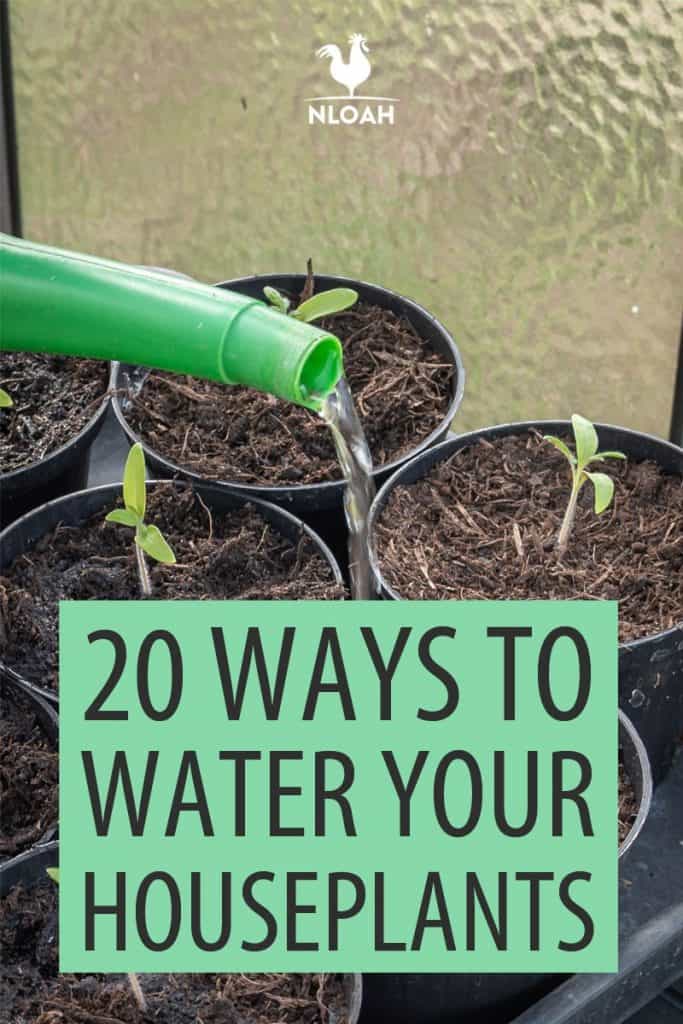Water is amazing – we know that. Without it, life on earth would not exist, at least not as we know it! That’s a simple fact that pretty much everybody accepts, but something people tend to have a much harder time wrapping their heads around?

If you’re anything like me, you probably find indoor houseplants a lot harder to grow than those that you cultivate outside. For some reason, I have a nasty habit of killing any plant that graces my windowsill. Usually, it’s due to some mistake in my watering habits.
Over time, I’ve learned a few easy ways to get my plants the water they need – without drowning them. There are some easy tips you can follow to ensure optimum plant health, no matter what you might be growing.
How Much Water Do Houseplants Need?
There are a few basics that you need to pay attention to when it comes to watering your houseplants.
For starters, water serves multiple functions in a plant. When you water, a process called transpiration occurs.
Through this process, the sun will evaporate water from the leaves, bringing the moisture to where it is needed the most. In a perfect world, the water would then be drawn up from the roots.
However, if your roots are dry, the plant will draw moisture from the leaves themselves. That’s why leaves look wilted when your plant is dry.
Your soil will act like a sponge. That’s why a porous soil is best, as it will provide room for air and water pockets.
Check the moisture of your soil before watering. If it feels damp, you don’t need to water. If the water starts pouring out from your container’s drainage holes immediately upon watering, your soil is bone dry, and is repelling water.
You should always water your plants after transplanting or repotting. They are vulnerable at this fragile time, especially when it comes to their roots. Make sure you give them an extra splash as soon as you’re done with this chore.
The exact amount of water required by a houseplant varies widely depending on what kind of plant you are going.
Growing a cactus or a similar type of succulent? You probably shouldn’t be watering any more often than once a month or so.
Other types of houseplants may need to be watered once a week or more – in fact, there are some bonsai plants that need to be watered every single day or even multiple times per day!
There are other variables that impact how much water your plants need, too. For instance, plants that are grown in large pots tend to dry out a lot faster than those grown in small ones.
When you grow plants in bright sunlight, you’ll find that they dry out more quickly than those grown in low lighting, too.
Also, if you live in a humid climate – or if your house is otherwise just damp – you may find that you don’t need to water your plants quite as frequently. If you live in the desert – or if your house just always feels dry and arid – you will need to water more often.
20 Ways to Water Your Houseplants
1. Soak Large Plants
Here’s a trick you can follow when watering large plants, which tend to have more expansive root systems. When you water, pour directly on the soil and let it soak in. Repeat this until the soil is fully saturated. Let it dry out until you water again.
If you’re growing a smaller plant, just semi-soak it. Place the plant in a try, then pour water over the soil until the tray has about half an inch of water. Let the plant sit for eight hours, then drain.
2. Mist with Epsom Salts
If your plants are deficient in sulfur and magnesium, you can lightly mist them with a mixture of Epsom salt and lukewarm water. You’ll likely find that your plants grow bushier and dense as a result.
3. Use Lukewarm Water
The ice cube watering method works well for most plants, as the ice cubes melt and absorb slowly into the soil. However, it’s important that you don’t confuse this with using ice water on your plants.
Warm water absorbs into soil much better than icy cold water. Use lukewarm water, and try not to splash any on the leaves, as it can cause fungal infections.
4. Use Hard Boiled Eggs
Eggs provide a great source of calcium for your soil. This can neutralize the pH, and make it easier for your plants to absorb other nutrients, too.
When you hard-boil eggs, don’t dump the water down the drain, but instead consider using it to water your plants.
5. Keep a Watering Container Close By
Chances are, if you can see your watering can every time you walk into the room, you’re going to be much more likely to water your plants than if you have to travel to another room to get it.
Keep a watering container handy and you’ll never have problems remembering to water.
6. Be Careful With Tap Water
If you have well water, tap water is probably fine – just make sure it isn’t too alkaline, which can harm houseplants.
However, you need to be careful about using tap water if it contains salt from softened water or if there are additives, like chlorine.
7. Use a Duster on Plant Leaves
A major difference between indoor- and outdoor-grown plants is that indoor plants collect dust over time. If you are able to dust your leaves every now and then, you’ll find that they photosynthesize and use water much more efficiently.
An easy way to dust your plants and provide necessary moisture is to use a damp sponge when dusting. You can also use a banana peel, which can repel aphids, and provide nutrients.
8. Drinks, Not Sips
When it’s time to water your plants, don’t be delicate about it. Plants prefer long, deep, slow drinks instead of occasional squirts of water.
Shallow watering will not help your plant develop strong root systems, which can make it more vulnerable to collapse.
9. Do the Finger Test
Not sure if your plants need water? Here’s an easy trick! Stick your finger into the soil, ideally up to your first knuckle.
Is the soil moist? If not – or if you can’t even get your finger into the soil – it’s time to water. If the top inch of soil feels moist and the dirt clings to your finger, you probably have enough water.
10. Water in the Morning
If you grow plants outside, too, you are probably already aware of the cardinal rule of watering: water in the morning, not at night. Watering at night will encourage moisture to remain on the plants, which can lead to fungal infection.
Water during the day and as early as possible, when transpiration and evaporation rates will be the highest.
11. Use a Watering Can
A watering can with a long spout will give you the best control when it comes to watering your plants. You’ll be able to water the soil without splashing your leaves.
Remember, wet leaves = fungus.
12. Water from the Bottom
Water from the bottom up. This will provide your plants water where they need it most – the roots – and not on the foliage.
If you need to remove excess salts from the soil, water from the top just once per month.
13. Use Bathwater
If you really want to recycle some water, consider saving bath or shower water to use to water your plants. Just make sure there’s not a ton of soap in it, although most plants can handle a bit of diluted soapy water!
14. Set a Schedule
Something I’ve found incredibly helpful when it comes to remember to water my plants is to set a schedule for myself. I put a timer into my cell phone that reminds me to water plants at certain intervals.
The important thing to remember is that, even though a schedule can remind you to do periodic check-ins, you shouldn’t be a slave to that schedule.
If you set your calendar to always remind you to water on Wednesdays, that doesn’t mean you have to water on Wednesday if the soil is still wet. This can do more harm than good, in fact, so make sure you adjust as needed.
When you’re setting your schedule, you also need to pay attention to the seasons. Seasons matter even when you’re growing plants indoors.
In the summer, the sunlight is much more intense – so some plants might need to be watered more often (even succulents). Tropical plants and ferns need to be watered weekly.
During the brighter and hotter periods of the year, you also need to make sure your plants stay humid.
15. The Damp Towel Method
This method of watering your plants works well if you’re going to be away for a while. Simply lay a towel down in a try, and humidify it before placing your plant in its pot on top.
Pour some water around it if you desire. This will create a zone of humidity close to the roots.
16. Add Some Clay Pebbles
Adding clay pebbles is a great way to improve moisture retention in the soil.
Layer water-retaining clay pebbles as a top layer above the soil. This will slow down evaporation.
17. Use a Self-Watering Pot
Self-watering pots are incredibly handy, especially if you’re like many of us and are prone to over- or under-watering. The plant container will take care of everything for you!
Just refill the water reservoir before it empties (usually, once a month or every other month). The container will take care of the rest!
18. The Garden Twine Hack
This method of watering plants is perfect if you’re headed out on vacation. All you need to do is fill up a bucket with tap water.
Set it on a table top. This will serve as your reservoir. Then, cut a few pieces of twine and humidify them by soaking them. Then place an end of each in the water reservoir.
Place the other end of the twine in your plant’s soil. The water reservoir will need to be slightly elevated so the water can make its way down, assisted by gravity. The twine will slowly bring water to your plants by capillary action.
19. Ice Cube Watering Method
The ice cub watering method is a simple technique that saves time and keeps your plants well-watered at the same time.
For this to work, you will need to place a few ice cubes into the pot of your plant. The ice will melt slowly over time, watering the plant slowly as it does so:

Just make sure you don’t put the cubes too close to the roots or stem of the plant – the cold can shock the system.
20. Save Your Dishwater and Cooking Water
Another way to water your plants in an energy- and time-efficient way is to save the water you use for things like cooking pasta or washing dishes (just make sure it doesn’t contain any food or soap).
If your plants are lacking in magnesium or calcium, you can also save water from boiling hardboiled eggs – this is a great way to supplement the added nutrients in a gentle way!
Common Mistakes When Watering Houseplants
One of the biggest mistakes that people make when watering their houseplants is not understanding how much water their plants actually need.
To figure this out, you can, of course, rely on the good old Internet. Look up the watering requirements for the plant you are trying to grow. You can also think carefully about your plants’ natural environment. Is it hot and dry – like a desert-native cactus – or is it rainy and tropical – like a fern?
Most people want to water their plants with abandon. The more hydrated, the better, right? Unfortunately, plants can drown if they get too much water. If the soil remains wet for too long, it can lead to root rot.
Not sure if you’re overwatering? If a plant hasn’t put on new growth in a while – or if its leaves are yellowing – that’s a sure sign that you’re providing too much water.
You might also notice wilted leaves, which can be confusing because that’s also a sign of too little water. Check the soil to see how moist it is to get a good idea of which situation applies to you.
Hopefully, these hacks will help you – and your plants! – get off on the right foot. With a bit of practice and routine, you’ll find that watering your house plants and keeping them healthy is easy-peasy.


Rebekah is a high-school English teacher n New York, where she lives on a 22 acre homestead. She raises and grows chickens, bees, and veggies such as zucchini (among other things).
